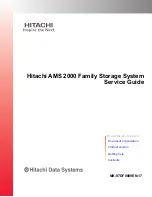
Overview
With today’s high dependency on access to business information, safe-guarded data and limited backup
windows, the reliability of the backup hardware and software is vital. Additionally, backup operations are
usually automated, often done at night, and any first pass operator intervention is done remotely. To assist
with these enterprise demands, Hewlett Packard Enterprise provides High Availability Failover features
for ESL G3 Tape Libraries and the MSL2024, MSL3040, MSL4048, MSL6480, MSL8048, and MSL8096
Tape Libraries with LTO-5 and LTO-6 Fibre Channel tape drives. Failover features are not supported on
the EML and ESL E-Series Tape Libraries.
• High Availability Data Path Failover— Both tape drive ports are connected to the SAN. Only one of the
ports is used at any one time and the second port is a standby port. When a link failure on the active
port is detected, the second port is used.
• High Availability Control Path Failover — Depending on the library and drive, one or both ports on the
control path drive are configured to present a path to the library controller and a second drive is
configured as a standby library control path drive. The library control path can be moved to a second
link on the drive hosting the control path in the event of a single path failure and in the event of a
complete control path drive connection loss, the standby library control path drive can be activated and
connection to the library control path can be moved to that drive.
With LTO-5 and LTO-6 tape drives, a driverless path failover feature uses library and drive firmware to
create a new Fibre Channel path to a drive or library if the original path is lost. Most applications
recognize the new path and some will automatically retry commands after the original path is lost. Other
applications may require user intervention to begin using the new path.
With LTO-6 tape drives, in addition to the driverless path failover feature, the libraries support a driver-
based path failover feature that uses drivers in conjunction with library and drive firmware to manage
multiple paths across multiple SANs, present a single drive or library path to applications, and
automatically transfer commands to the new path if the original path is lost. This transfer is invisible to
most applications, avoiding the need for user intervention.
These failover features are presented in the library user interface as basic and advanced failover.
• Basic failover
◦ Supported on LTO-5 and LTO-6 FC tape drives. Data path failover requires a dual-ported drive.
◦ Supported by a combination of tape drive and library firmware features to create a new Fibre
Channel path to a drive or library if the original path is lost.
◦ Most applications recognize the new path and some applications will automatically retry commands
after the original path is lost. Some applications might require user intervention to begin using the
new path.
◦ Available for the MSL2024, MSL4048, MSL6480, MSL8048, MSL8096, and ESL G3 Tape Libraries.
• Advanced failover
◦ Supported on LTO-6 FC tape drives.
◦ Requires host driver support, in addition to tape drive and library firmware features, to manage
multiple paths across multiple SANs, present a single drive or library path to applications, and
automatically transfer commands to the new path if the original path is lost.
◦ The transfer to the failover path is invisible to most applications, avoiding the need for user
intervention.
6
Overview







































